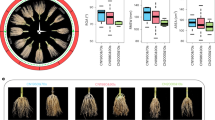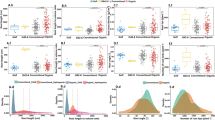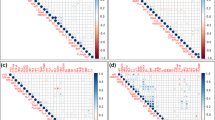Abstract
The maize root system has been reshaped by indirect selection during global adaptation to new agricultural environments. In this study, we characterized the root systems of more than 9,000 global maize accessions and its wild relatives, defining the geographical signature and genomic basis of variation in seminal root number. We demonstrate that seminal root number has increased during maize domestication followed by a decrease in response to limited water availability in locally adapted varieties. By combining environmental and phenotypic association analyses with linkage mapping, we identified genes linking environmental variation and seminal root number. Functional characterization of the transcription factor ZmHb77 and in silico root modeling provides evidence that reshaping root system architecture by reducing the number of seminal roots and promoting lateral root density is beneficial for the resilience of maize seedlings to drought.
This is a preview of subscription content, access via your institution
Access options
Access Nature and 54 other Nature Portfolio journals
Get Nature+, our best-value online-access subscription
$29.99 / 30 days
cancel any time
Subscribe to this journal
Receive 12 print issues and online access
$209.00 per year
only $17.42 per issue
Buy this article
- Purchase on Springer Link
- Instant access to full article PDF
Prices may be subject to local taxes which are calculated during checkout






Similar content being viewed by others
Data availability
All raw seminal root phenotyping data, geographical coordinates and soil modeling data are provided in Supplementary Tables 1–8. All germplasm information that is the geographically diverse teosinte accessions, maize traditional varieties and inbred lines contributed by NCRPIS, CIMMYT and the Chinese maize seed germplasm bank at the Institute of Crop Sciences, Chinese Academy of Agricultural Sciences (China) used in this study are summarized in the Supplementary Tables 1–5. Geographical coordinates and elevation information of the collection sites for the traditional maize varieties were retrieved from the public database of the US National Plant Germplasm System (https://www.grin-global.org). Soil and climate data were collected from WorldClim (https://worldclim.org), the NCEP/NCAR Reanalysis Project (https://psl.noaa.gov/data/reanalysis/reanalysis.shtml), NASA SRB (https://asdc.larc.nasa.gov/project/SRB), Climate Research Unit (https://www.uea.ac.uk/groups-and-centres/climatic-research-unit), SoilGrids (https://soilgrids.org v.2) and the Global Soil Dataset (https://www.fao.org/soils-portal/data-hub/soil-maps-and-databases/harmonized-world-soil-database-v12/en). Maize genome resequencing data of the Gaspé Flint introgression panel and root RNA sequencing data were deposited in the Sequence Read Archive (http://www.ncbi.nlm.nih.gov/sra) under the BioProject ID PRJNA1095206. Source data are provided with this paper.
Code availability
The customized scripts included in this study are available at GitHub (https://github.com/PengYuMaize/GlobalSeminalRoot) with https://doi.org/10.5281/zenodo.10985812 (ref. 83).
References
Meyer, R. S. & Purugganan, M. D. Evolution of crop species: genetics of domestication and diversification. Nat. Rev. Genet. 14, 840–852 (2013).
Hake, S. & Ross-Ibarra, J. Genetic, evolutionary and plant breeding insights from the domestication of maize. eLife 4, e05861 (2015).
Yang, N. et al. Two teosintes made modern maize. Science 382, 1013 (2023).
Ross-Ibarra, J. & Piperno, D. Maize moving. Figshare https://doi.org/10.6084/m9.figshare.12781307.v1 (2020).
Romero Navarro, J. A. et al. A study of allelic diversity underlying flowering-time adaptation in maize landraces. Nat. Genet. 49, 476–480 (2017).
Swarts, K. et al. Genomic estimation of complex traits reveals ancient maize adaptation to temperate North America. Science 357, 512–515 (2017).
Ma, Z. et al. Evolutionary history resolves global organization of root functional traits. Nature 555, 94–97 (2018).
Eshel, A. & Beeckman, T. (eds) Plant roots: the hidden half (CRC Press, 2013).
Hochholdinger, F., Yu, P. & Marcon, C. Genetic control of root system development in maize. Trends Plant Sci. 23, 79–88 (2018).
Lopez-Valdivia, I. et al. Gradual domestication of root traits in the earliest maize from Tehuacán. Proc. Natl Acad. Sci. USA 119, e2110245119 (2022).
Yu, P., Gutjahr, C., Li, C. & Hochholdinger, F. Genetic control of lateral root formation in cereals. Trends Plant Sci. 21, 951–961 (2016).
Golan, G., Hendel, E., Méndez Espitia, G. E., Schwartz, N. & Peleg, Z. Activation of seminal root primordia during wheat domestication reveals underlying mechanisms of plant resilience. Plant Cell Environ. 41, 755–766 (2018).
Perkins, C. & Lynch, J. P. Increased seminal root number associated with domestication improves nitrogen and phosphorus acquisition in maize seedlings. Ann. Bot. 128, 453–468 (2021).
Hochholdinger, F., Woll, K., Sauer, M. & Dembinsky, D. Genetic dissection of root formation in maize (Zea mays) reveals root‐type specific developmental programmes. Ann. Bot. 93, 359–368 (2004).
Burton, L., Brown, K. M. & Lynch, J. P. Phenotypic diversity of root anatomical and architectural traits in Zea species. Crop Sci. 53, 1042–1055 (2013).
Taramino, G. et al. The maize (Zea mays L.) RTCS gene encodes a LOB domain protein that is a key regulator of embryonic seminal and post‐embryonic shoot‐borne root initiation. Plant J. 50, 649–659 (2007).
Merrill, W. L. et al. The diffusion of maize to the southwestern United States and its impact. Proc. Natl Acad. Sci. USA 106, 21019–21026 (2009).
da Fonseca, R. R. et al. The origin and evolution of maize in the Southwestern United States. Nat. Plants 1, 14003 (2015).
Doebley, J. F., Goodman, M. & Stuber, C. W. Exceptional genetic divergence of northern flint corn. Am. J. Bot. 73, 64–69 (1986).
Rebourg, C. et al. Maize introduction into Europe: the history reviewed in the light of molecular data. Theor. Appl. Genet. 106, 895–903 (2003).
Hu, Y. et al. Genome assembly and population genomic analysis provide insights into the evolution of modern sweet corn. Nat. Commun. 12, 1227 (2021).
Salvi, S. et al. Genetic dissection of maize phenology using an intraspecific introgression library. BMC Plant Biol. 11, 4 (2011).
Osthoff, A. et al. Transcriptomic reprogramming of barley seminal roots by combined water deficit and salt stress. BMC Genom. 20, 325 (2019).
Zhou, X. et al. CPlantBox, a whole-plant modelling framework for the simulation of water- and carbon-related processes. in silico Plants 2, diaa001 (2020).
Ahmed, M. A., Zarebanadkouki, M., Kaestner, A. & Carminati, A. Measurements of water uptake of maize roots: the key function of lateral roots. Plant Soil 398, 59–77 (2016).
Abdalla, M. et al. Stomatal closure during water deficit is controlled by below-ground hydraulics. Ann. Bot. 129, 161–170 (2022).
Cai, G., Ahmed, M. A., Abdalla, M. & Carminati, A. Root hydraulic phenotypes impacting water uptake in drying soils. Plant Cell Environ. 45, 650–663 (2022).
Li, C. et al. Genomic insights into historical improvement of heterotic groups during modern hybrid maize breeding. Nat. Plants 8, 750–763 (2022).
Marcon, C. et al. BonnMu: a sequence-indexed resource of transposon-induced maize mutations for functional genomics studies. Plant Physiol. 184, 620–631 (2020).
Qiu, X. et al. Genome-wide identification of HD-ZIP transcription factors in maize and their regulatory roles in promoting drought tolerance. Physiol. Mol. Biol. Plants 28, 425–437 (2022).
Salvi, S. et al. Registration of Gaspé Flint 1.1.1, a small-size early-flowering maize inbred line. J. Plant Registrat. 16, 152–161 (2021).
Giehl, R. F. & von Wirén, N. Root nutrient foraging. Plant Physiol. 166, 509–517 (2014).
Tenaillon, M. I. & Charcosset, A. A European perspective on maize history. Biologies 334, 221–228 (2011).
Liu, Y. et al. Genomic basis of geographical adaptation to soil nitrogen in rice. Nature 590, 600–605 (2021).
Jägermeyr, J. et al. Climate impacts on global agriculture emerge earlier in new generation of climate and crop models. Nat. Food 2, 873–885 (2021).
Yuan, X. et al. A global transition to flash droughts under climate change. Science 380, 187–191 (2023).
Schneider, H. M. et al. Multiseriate cortical sclerenchyma enhance root penetration in compacted soils. Proc. Natl Acad. Sci. USA 118, e2012087118 (2021).
Wang, X. et al. Genetic variation in ZmVPP1 contributes to drought tolerance in maize seedlings. Nat. Genetics 48, 1233–1241 (2016).
Grando, S. & Ceccarelli, S. Seminal root morphology and coleoptile length in wild (Hordeum vulgare ssp. spontaneum) and cultivated (Hordeum vulgare ssp. vulgare) barley. Euphytica 86, 73–80 (1995).
Orosa-Puente, B. et al. Root branching toward water involves posttranslational modification of transcription factor ARF7. Science 362, 1407–1410 (2018).
Mehra, P. et al. Hydraulic flux-responsive hormone redistribution determines root branching. Science 378, 762–768 (2022).
Maurel, C. & Nacry, P. Root architecture and hydraulics converge for acclimation to changing water availability. Nat. Plants 6, 744–749 (2020).
Liu, K. et al. Genetic structure and diversity among maize inbred lines as inferred from DNA microsatellites. Genetics 165, 2117–2128 (2003).
Gouesnard, B. et al. Genotyping-by-sequencing highlights original diversity patterns within a European collection of 1191 maize flint lines, as compared to the maize USDA genebank. Theor. Appl. Genet. 130, 2165–2189 (2017).
Yu, P. et al. Plant flavones enrich rhizosphere Oxalobacteraceae to improve maize performance under nitrogen deprivation. Nat. Plants 7, 481–499 (2021).
Metzner, R. et al. In vivo imaging and quantification of carbon tracer dynamics in nodulated root systems of pea plants. Plants 11, 632 (2022).
Streun, M. et al., PhenoPET: a dedicated PET scanner for plant research based on digital SiPMs (DPCs). In IEEE Medical Imaging Conference (IEEE, 2014).
Hinz, C. Accurate quantitative and dynamic PET imaging with the phenoPET Scanner for plant studies. PhD dissertation, University of Wuppertal (2021).
Scheins, J. J. et al. High performance volume-of-intersection projectors for 3D-PET image reconstruction based on polar symmetries and SIMD vectorisation. Phys. Med. Biol. 60, 9349–9375 (2015).
Bauer, F. M. et al. Development and validation of a deep learning based automated minirhizotron image analysis pipeline. Plant Phenoics 2022, 9758532 (2022).
Smith, A. G. et al. RootPainter: deep learning segmentation of biological images with corrective annotation. New Phytol. 236, 774–791 (2022).
Leitner, D. et al. Recovering root system traits using image analysis exemplified by two-dimensional neutron radiography images of lupine. Plant Physiol. 164, 24–35 (2014).
Lobet, G. et al. A novel image-analysis toolbox enabling quantitative analysis of root system architecture. Plant Physiol. 157, 29–39 (2011).
Lobet, G. et al. Root system markup language: toward a unified root architecture description language. Plant Physiol. 167, 617–627 (2015).
Schnepf, A. et al. CRootBox: a structural–functional modelling framework for root systems. Ann. Bot. 121, 1033–1053 (2018).
Chimungu, J. G. et al. Reduced root cortical cell file number improves drought tolerance in maize. Plant Physiol. 166, 1943–1955 (2014).
Gao, K. et al. A comprehensive analysis of root morphological changes and nitrogen allocation in maize in response to low nitrogen stress. Plant Cell Environ. 38, 740–750 (2015).
Yang, J. T. et al. Genotypic variation and nitrogen stress effects on root anatomy in maize are node specific. J. Exp. Bot. 70, 5311–5325 (2019).
Heymans, A. et al. Combining cross‐section images and modeling tools to create high‐resolution root system hydraulic atlases in Zea mays. Plant Direct 5, e334 (2021).
Heymans, A. et al. GRANAR, a computational tool to better understand the functional importance of monocotyledon root anatomy. Plant Physiol. 182, 707–720 (2020).
Couvreur, V. et al. Going with the flow: multiscale insights into the composite nature of water transport in roots. Plant Physiol. 178, 1689–1703 (2018).
Heymans, A. In silico analysis of the influence of root hydraulic anatomy on maize (Zea mays) water uptake. PhD dissertation, Université Catholique de Louvain (2022).
Meunier, F. et al. MARSHAL, a novel tool for virtual phenotyping of maize root system hydraulic architectures. in silico Plants 2, diz012 (2020).
Lasky, J. et al. Genome–environment associations in sorghum landraces predict adaptive traits. Sci. Adv. 1, e1400218 (2015).
Zomer, R. J., Trabucco, A., Bossio, D. A. & Verchot, L. V. Climate change mitigation: a spatial analysis of global land suitability for clean development mechanism afforestation and reforestation. Agric. Ecosyst. Environ. 126, 67–80 (2008).
Kalnay, E. et al. The NCEP/NCAR 40-year reanalysis project. Bull. Am. Meteorol. Soc. 77, 437–472 (1996).
New, M., Lister, D., Hulme, M. & Makin, I. A high-resolution data set of surface climate over global land areas. Clim. Res. 21, 1–25 (2002).
Hengl, T. et al. SoilGrids250m: global gridded soil information based on machine learning. PLoS One 12, e0169748 (2017).
Shangguan, W., Dai, Y., Duan, Q., Liu, B. & Yuan, H. A global soil data set for earth system modeling. J. Adv. Model. Earth Syst. 6, 249–263 (2014).
Sanchez, P. A., Palm, C. A. & Buol, S. W. Fertility capability soil classification: a tool to help assess soil quality in the tropics. Geoderma 114, 157–185 (2003).
Fan, Y., Li, H. & Miguez-Macho, G. Global patterns of groundwater table depth. Science 339, 940–943 (2013).
Kursa, M. B. & Rudnicki, W. R. Feature selection with the Boruta package. J. Stat. Soft. 36, 1–13 (2010).
Liaw, A. & Wiener, M. Classification and regression by randomForest. R News 2, 18–22 (2002).
Gates D. J. et al. Single-gene resolution of locally adaptive genetic variation in Mexican maize. Preprint at https://doi.org/10.1101/706739 (2019).
de Leeuw, C. A. et al. MAGMA: generalized gene-set analysis of GWAS data. PLoS Comput. Biol. 11, e1004219 (2015).
Caye, K. et al. TESS3: fast inference of spatial population structure and genome scans for selection. Mol. Ecol. Resour. 16, 540–548 (2016).
Li, H. & Durbin, R. Fast and accurate short read alignment with Burrows–Wheeler transform. Bioinformatics 25, 1754–1760 (2009).
Li, H. et al. The sequence alignment/map format and SAMtools. Bioinformatics 25, 2078–2079 (2009).
Browning, B. L. & Browning, S. R. Genotype imputation with millions of reference samples. Am. J. Hum. Genet. 98, 116–126 (2016).
Alexander, D. H., Novembre, J. & Lange, K. Fast model-based estimation of ancestry in unrelated individuals. Genome Res. 19, 1655–1664 (2009).
Li, Q. et al. CRISPR/Cas9‐mediated knockout and overexpression studies reveal a role of maize phytochrome C in regulating flowering time and plant height. Plant Biotechnol. J. 18, 2520–2532 (2020).
Yu, P., Eggert, K., von Wirén, N., Li, C. & Hochholdinger, F. Cell type-specific gene expression analyses by RNA sequencing reveal local high nitrate-triggered lateral root initiation in shoot-borne roots of maize by modulating auxin-related cell cycle regulation. Plant Physiol. 169, 690–704 (2015).
Yu, P. PengYuMaize/GlobalSeminalRoot. Zenodo https://doi.org/10.5281/zenodo.10985812 (2024).
Acknowledgements
We thank J. Ross-Ibarra (University of California–Davis, USA) for comments on the manuscript. We are grateful to the North Central Regional Plant Introduction Station (NCRPIS, USDA-ARS and Iowa State University, Ames, Iowa, USA) and the International Maize and Wheat Improvement Center (CIMMYT) for providing seeds for this work. NCRPIS is part of the USDA-ARS National Plant Germplasm System. We thank A. Charcosset (GQE‐Le Moulon, INRAE, Univ. Paris‐Sud, CNRS, AgroParisTech, Université Paris‐Saclay, Gif‐sur‐Yvette, France) and M. López Luaces (Centro Investigacións Agrarias Mabegondo, Spain) for contributing European maize germplasm. We thank S. Mayer and S. Wagner (Leibniz Institute of Plant Genetics and Crop Plant Research, Gatersleben, Germany) for technical support for NMR, and S. Ortleb, L. Kalms and P. Hinrichs (Leibniz Institute of Plant Genetics and Crop Plant Research, Gatersleben, Germany) for image segmentation. We thank S. Siemens, A. Brox and H. Rehkopf (Crop Functional Genomics, INRES, University of Bonn, Germany) for root phenotyping and DNA extraction. This work was supported by the Deutsche Forschungsgemeinschaft (DFG) grants HO2249/22-1 to F.H. and YU272/1-1 to P.Y., the DFG Emmy Noether Programme (444755415 to P.Y.), the DFG SPP2089 “Rhizosphere spatiotemporal organisation—a key to rhizosphere functions” (403671039 to F.H. and P.Y., 403641034 to A.S.), the USDA National Institute of Food and Agriculture and Hatch Appropriations (PEN04734 and 1021929 to R.J.H.S.), Consejo Nacional de Ciencia Tecnologia (FOINS-2016-01 to R.J.H.S.), National Science Foundation (1546719 to R.J.H.S.), the National Key Research and Development Program of China (2021YFD1200700, 2016 YFD0100103 and 2020YFE0202300 to T.W.), the Innovation Program of Chinese Academy of Agricultural Sciences to T.W., the Innovation Research 2035 Pilot Plan of Southwest University (SWU-XDZD22001 to X.C.), the US Department of Agriculture, Agricultural Research Service (USDA-ARS) to V.B., the TED2021-130908B-C41/AEI/10.13039/501100011033/Unión Europea NextGenerationEU/PRTR and the Spanish Ministry of Science and Innovation for the I + D + i project PID2020-115813RA-I00 funded by MCIN/AEI/10.13039/501100011033 to M.D. This work was partially funded by the DFG under Germany’s Excellence Strategy–EXC 2070 (390732324 to P.Y. and A.S.). R.K., D.v.D., R.M. and D.P. acknowledge support from the Helmholtz Association for the Forschungszentrum Jülich GmbH and thank A. Chlubek, G. Huber and J. Bühler for technical support with MRI and PET. The germplasm propagation is funded by the TRA Sustainable Futures (University of Bonn) as part of the Excellence Strategy of the federal and state governments.
Author information
Authors and Affiliations
Contributions
P.Y. and F.H. conceived and designed the project. P.Y. coordinated the project. P.Y., C.-H.L., X.H., H.L., A.M., M.F.R.R.J., M.M., C.-C.S. and C.M. performed phenotyping, collected and prepared samples. P.Y., C.-H.L., M.L., D.W., R.J.H.S., T.W. and F.H. conducted bioinformatics analyses and analyzed data. R.K., R.M., D.v.D. and D.P. performed MRI–PET root imaging and analyzed data. L.B. and I.P. performed NMR seed imaging and analyzed data. M.L., S.P., C.M.M., M.D. and R.J.H.S. performed ecological and environmental analyses. F.M.B., A.S., G.L. and A.H. performed structural–functional modeling analyses. A.A., M.A. and M.A.A. performed the soil hydraulic modeling experiment and data analyses. K.S. and L.S. performed lignin analyses. Y.L., X.C., S.S., V.B., N.v.W., C.-J.L. and T.W. contributed valuable suggestions for the analysis and interpretation of results. P.Y., C.-H.L., M.L., R.J.H.S., T.W. and F.H. wrote the manuscript. All authors read and approved the paper.
Corresponding authors
Ethics declarations
Competing interests
The authors declare no competing interests.
Peer review
Peer review information
Nature Genetics thanks the anonymous reviewer(s) for their contribution to the peer review of this work. Peer reviewer reports are available.
Additional information
Publisher’s note Springer Nature remains neutral with regard to jurisdictional claims in published maps and institutional affiliations.
Supplementary information
Supplementary Information
Supplementary Figs. 1–17.
Supplementary Data 1
Supplementary Tables 1–15 (Description is shown individually in actual Excel sheet itself).
Source data
Source Data Fig. 1
Statistical source data.
Source Data Fig. 2
Statistical source data.
Source Data Fig. 3
Statistical source data.
Source Data Fig. 4
Statistical source data.
Source Data Fig. 5
Statistical source data.
Source Data Fig. 6
Statistical source data.
Rights and permissions
Springer Nature or its licensor (e.g. a society or other partner) holds exclusive rights to this article under a publishing agreement with the author(s) or other rightsholder(s); author self-archiving of the accepted manuscript version of this article is solely governed by the terms of such publishing agreement and applicable law.
About this article
Cite this article
Yu, P., Li, C., Li, M. et al. Seedling root system adaptation to water availability during maize domestication and global expansion. Nat Genet 56, 1245–1256 (2024). https://doi.org/10.1038/s41588-024-01761-3
Received:
Accepted:
Published:
Issue Date:
DOI: https://doi.org/10.1038/s41588-024-01761-3



